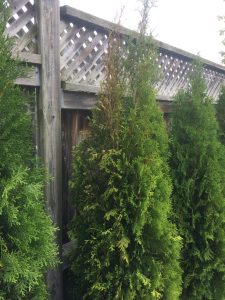
I live in the GTA and have planted 10 6ft Emerald Cedars early this spring. They have all done really well until now with the exception of 1 which is now showing signs of trouble. They are planted along a fence line, have full sun and are well drained. We have had lots of rain this year and when it hasn’t rained for about a week we have put our soaker hose on and ran it for about an hour for a deep soak. They also have a good amount of mulch around the base. One now seems to be partially dying. The foliage are turning crisp and dry at the top and towards the back on one particular shoot. They crumble when touched. The rest of the tree is in fantastic shape for now. The bottom of the tree is great so I’m not sure about root rot. Could this be a Sun Burn or would it be a problem coming from the roots? It does seem to be in line with the way the sun comes over the house. Will this come back in the spring with new buds or will this take over the tree and kill it? Should this be cut out or just left alone? If it is a problem with the root is there something I can do to amend the roots? Thanks for any help.
It sounds like the cedars are in an ideal spot, and the good news is that the other 9 are doing well, which likely means that you are caring for them appropriately!
You are right, we’ve had lots of rain this season (it’s now mid-August) but the cedars need consistent moisture to become established – it appears that you are tending your trees well by watering them deeply during rain-free periods. Generally, cedars should receive deep watering once or twice a week.
As well, mulching under the trees should be helpful – this is great for the roots, as it will hold moisture around them, maintain the temperature relatively constant and shade them. Mulch should not be mounded against the trunk, but should be kept at least 15 cm (6 inches) away from the tree trunk (not mounded against it) to prevent rotting, fungal diseases and pests.
It’s not clear whether you have fertilized the trees – use of a 30-10-10 fertilizer three times during the growing season (May, June, July) is recommended. Apply as directed, as too much fertilizer can “burn” the roots by drawing moisture away from them, resulting in brown foliage. But if this were the case, your other trees should be suffering, too.
It’s less likely, but possible, that pests or disease (e.g., fungus) have attacked your tree. It is common to see die-back of around 30% of the foliage each year – but towards the end of the season. Cedars usually brown from the inside out, not at the top, as you describe. See The Spruce. Why are my emerald cedar leaves turning brown? This article discusses browning due to aphids, spider mites and fungal disease, as well as what to look for with each. It also discusses a major issue, where the trees don’t get enough water. I’m not sure if your tree is frequently visited by dogs, but note that the article also mentions that dog urine can contribute to browning leaves.
We receive lots of questions about browning cedars. I’d suggest that you search for relevant postings on our website (search using the word “emerald”. For example see:
Your tree’s problem does not appear to be “sunburn” – this usually refers to browning that is seen after a tough winter season. However, you seem to suggest that that particular tree is somehow in line with the path of the sun over the house. It is not clear what you mean by this, so I cannot comment.
Until the cause of this problem is identified, it is not possible to predict whether it will return next spring or even kill the tree. And since we don’t know what ails the tree, go ahead and prune out the brown foliage. Keep some of the cuttings (sealed in a clear plastic bag) to show to an expert at your nursery. Discard the rest in the garbage – do not compost it.
Finally, I suggest that you go back to the nursery where you purchased the trees. Discuss with their expert how you have cared for the trees and the browning of this single tree – they may have some suggestions. And if your tree continues to worsen, the nursery may replace it for you – some nurseries guarantee their stock for up to a couple of years.

